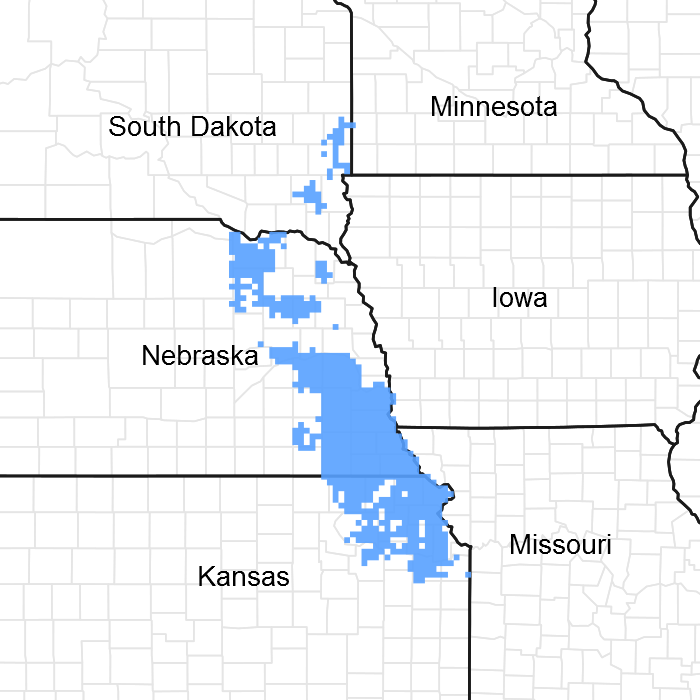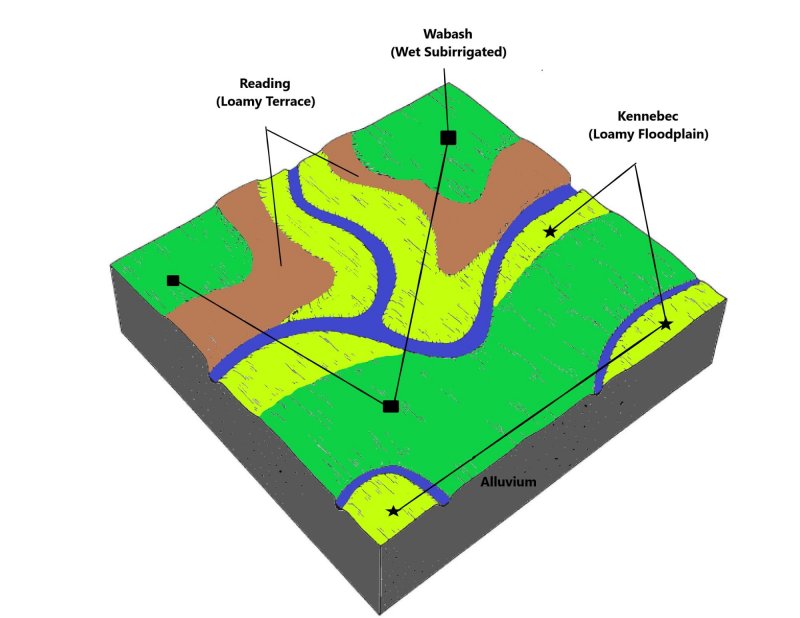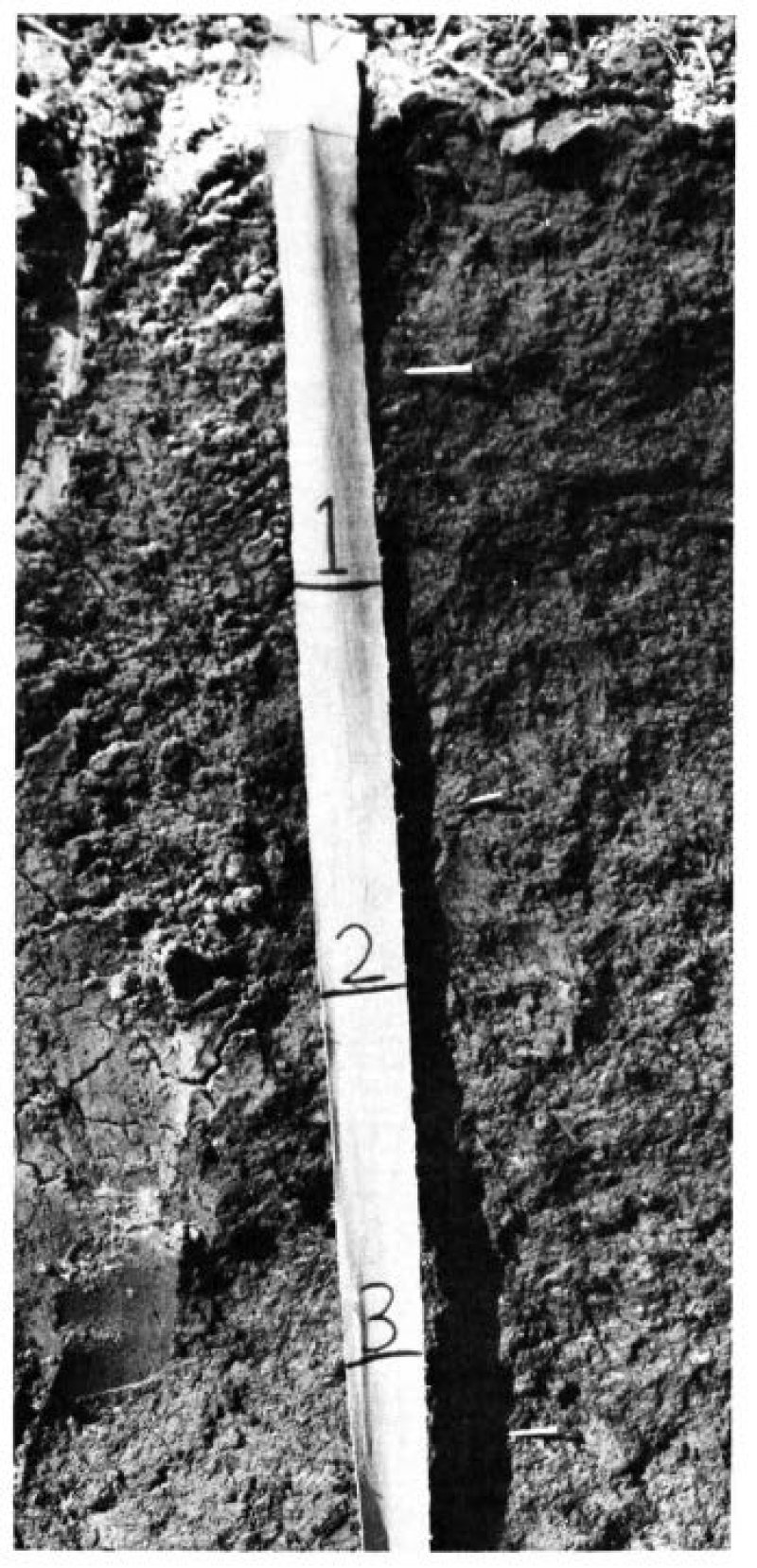Ecological dynamics
Wet Subirrigated sites developed under Northern Great Plains climatic conditions, light to severe grazing by bison and other large herbivores, sporadic natural or man-caused wildfires, and other biotic and abiotic factors which typically influence soil/site development. This continues to be a disturbance-driven site, by herbivory, fire, local hydrology, and variable climate. Changes occur in the plant communities due to weather variations, changes in the local hydrological cycle, impacts of native and/or exotic plant and animal species, and management actions.
The majority of this site has been impacted agricultural practices, both through soil disturbance and the accumulation of chemically contaminated run-off. A significant portion of the remaining acres have been degraded by season-long continuous grazing by domestic livestock. This management practice causes the repeated removal of the growing point and excessive defoliation of the leaf area of individual tall warm-season grasses. The resulting reduction of the ability of the plants to harvest sunlight depletes the root reserves, subsequently decreasing the root mass. This negatively impacts the ability of the plants to compete for life-sustaining nutrients, resulting in declining vigor and eventual mortality. The space created in the vegetative community is then occupied by a species that evades the negative grazing impacts by a growing season adaptation (such as a cool season), a shorter structure, or a reduced palatability mechanism.
The State-and-Transition Model (STM) is depicted below, and is made up of a Reference State, a Degraded State, and a Sod-busted State. Each state represents the crossing of a major ecological threshold due to alteration of the functional dynamic properties of the ecosystem. The main properties observed to determine this change are the soil and vegetative communities and the hydrological cycle.
Each state may have one or more vegetative communities which fluctuate in species composition and abundance within the normal parameters of the state. Within each state, communities may degrade or recover in response to natural and man-caused disturbances such as variation in the degree and timing of herbivory, presence or absence of fire, and climatic and local fluctuations in the precipitation regime.
Interpretations are primarily based on the Reference State, and have been determined by study of rangeland relic areas, areas protected from excessive disturbance, and areas under long-term rotational grazing regimes. Trends in plant community dynamics have been interpreted from heavily grazed to lightly grazed areas, seasonal use pastures, and historical accounts. Plant communities, states, transitional pathways, and thresholds have been determined through similar studies and experience.
Growth of native cool-season plants begins about April 1, and continues to about June 15. Native warm-season plants begin growth about May 15, and continue to about August 15. Green-up of cool-season plants may occur in September and October if adequate moisture is available.
The following is a diagram illustrating the common plant communities that can occur on the site and the transition pathways between communities.
State 1
Reference State
This state describes the range of vegetative community phases that occur on the Wet Subirrigated ecological site where the natural processes are mostly intact.
The Reference Community is a representation of the native plant community phase that occupies a site that has been minimally altered by management. Due to differences in hydrology resulting in different periods and degrees of surface inundation, this site harbors a distinctive inclusion in some of the reference communities. The more water-tolerant vegetative community expressed in these inclusions can be described as a herbaceous wetland zone features, while the Tallgrass Wet Meadow Zone is comprised of more of the Tallgrass Prairie species. The boundary between the two communities is dynamic, and driven by local hydrology. The Degraded Native Grass, the At-Risk Native Grass, and the Excessive Litter Communities are the phases that result from management decisions that are unfavorable for a healthy Reference Community. The Ephemeral Forb Community is the result of a high-intensity disturbance event.
High perennial grass cover and production allow for increased soil moisture retention, vegetative production, and overall soil quality.
Community 1.1
Tallgrass Wet Meadow Zone
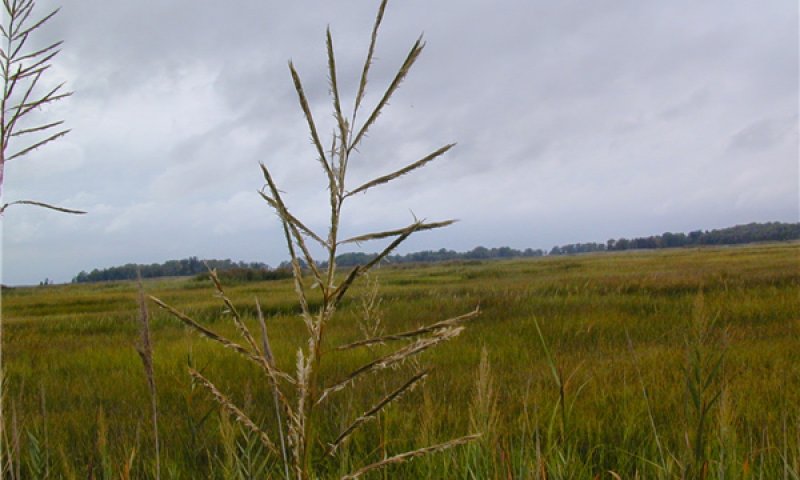
Figure 8. Tallgrass Wet Meadow-Reference Community
The Tallgrass Wet Meadow Zone serves as a description of the native plant community that naturally occurs on the site when the natural disturbance regimes are intact, or closely mimicked by management practices. This phase is dynamic, with fluid relative abundance and spatial boundaries between the dominant structural vegetative groups. These fluctuations are primarily driven by different responses of the species to changes in precipitation timing and abundance, hydrology, and fire and grazing events.
The potential vegetation consists of approximately 70-85 percent grasses and grass-like plants, 5-15 percent forbs, and 0-5 percent shrubs. Prairie cordgrass, big bluestem, Indiangrass, and switchgrass are the primary species in this community. Secondary species include little bluestem, sedges and Canada wildrye. The site also has a diverse forb population.
This plant community is highly productive, diverse, and resistant to short term stresses such as drought and short periods of heavy stocking. The well-developed root systems support resiliency when allowed adequate recovery periods between grazing events.
When exposed to long-term or frequent over-grazing events without adequate rest, this plant community will degrade.
The Reference State includes inclusions of a wetter environment, and a vegetative community that is more water tolerant than the Tallgrass Wet Meadow Zone. The primary grasses in this community are prairie cordgrass, and bluejoint. Sedges, rushes, bulrushes, and a variety of water tolerant forbs make up the remainder of the community, though some areas harbor deciduous tree communities. The boundary between the two communities is somewhat dynamic, and fluctuates as a result of changes in the local hydrology.
Grazing during wet periods can cause excessive soil compaction, and lead to hummocking.
The average annual vegetative production of the Tallgrass Wet Meadow Zone varies from 4,000 lbs per acre in the north, to 8,000 in the southern region.
| Jan |
Feb |
Mar |
Apr |
May |
Jun |
Jul |
Aug |
Sep |
Oct |
Nov |
Dec |
| J |
F |
M |
A |
M |
J |
J |
A |
S |
O |
N |
D |
Community 1.2
Degraded Native Grass Community
Prairie cordgrass, big bluestem, switchgrass, Indiangrass, and other desirable species lose productive capacity through loss of vigor and reproductive potential. Grazing-evasive warm-season and cool-season grasses such as little bluestem, sedges, and cool-season grasses increase. Bromegrass and Kentucky bluegrass begin to establish.
Subirrigation of the deep-rooted tallgrasses on this site helps to sustain the reference plant community, but the degradation of the vegetative community is apparent. This community phase signals a significant loss of production. The composition of the forb component remains diverse, but the potential for encroachment by invasive woody species becomes more likely, due to fewer deep-rooted species and a reduced fuel load to carry fire.
This shift occurs is due to management strategies that include continuous season-long grazing with inadequate recovery periods. While this plant community is less productive and less diverse than the representative plant community, it remains sustainable in regards to site/soil stability, watershed function, and biologic integrity.
Community 1.3
At-Risk Native Grass Community
In this plant community, the more palatable warm-season tallgrasses have been reduced to remnant populations by continued defoliation during their critical growth periods. Grazing-evasive warm-season and cool-season grasses increase significantly. Sideoats grama, tall dropseed, smooth bromegrass, and Kentucky bluegrass become the dominant grasses. Tall fescue is an increaser in the south. The more palatable forbs give way to goldenrod, ironweed, Cuman ragweed, and other grazing-evasive species. On the wetter sites, reed canarygrass increases to near-dominance.
Soil health is affected by reduced efficiency in the nutrient, mineral, and hydrologic cycles as a result of decreases in plant litter and rooting depths. Hoof action may initiate the formation of a compacted soil layer. Total annual vegetative production will decline significantly. Without a management change, this community is at-risk to degrade to the Native/Invaded Grass State.
| Jan |
Feb |
Mar |
Apr |
May |
Jun |
Jul |
Aug |
Sep |
Oct |
Nov |
Dec |
| J |
F |
M |
A |
M |
J |
J |
A |
S |
O |
N |
D |
Community 1.4
Excessive Litter Community
The Excessive Litter Community Phase describes the response of the community to the removal of the natural disturbances of herbivory and fire. As the undisturbed duff layer deepens, infiltration of the precipitation is interrupted and evaporation increases significantly, simulating drought-like conditions.
Community 1.5
Ephemeral Forb Community
This community describes the flush of forbs that occurs in response to a major disturbance, or combination of disturbances. Growing season wildfire followed by hail, extreme prolonged drought, or extreme defoliation by herbivores are all examples of these disturbances. The native warm-season grasses re-establish dominance with in a few years of the event.
Pathway CP 1.1-1.2
Community 1.1 to 1.2
A shift from the Tallgrass Meadow to the Degraded Native Grass community occurs with continuous season long grazing and inadequate recovery periods during the growing season.
Pathway CP 1.2-1.4
Community 1.1 to 1.4
Prolonged interruption of the natural disturbances of herbivory and fire will result in conversion from this community to the Excessive Litter Community.
Pathway CP 1.2-1.5
Community 1.1 to 1.5
A high-impact disturbance event or combination of events causing excessive defoliation of the vegetation, i.e. a growing season wildfire followed by a significant hailstorm, or a prolonged intensive grazing event or long-term drought, etc.
Pathway CP 1.2-1.1
Community 1.2 to 1.1
A shift from the Degraded Native Grass community toward the Reference communities can be achieved through prescribed grazing. Applying grazing pressure during the growth period of the undesirable cool season grasses, and allowing rest during the warm season growing season favors our desired species. This grazing regime will enable the deeply rooted tall warm season grasses to out compete the shallow rooted grazing evasive warm season and the cool season grasses.
Appropriately timed prescribed fire will accelerate this process.
| Prescribed Burning |
|
| Access Control |
|
| Prescribed Grazing |
|
Pathway CP 1.2-1.3
Community 1.2 to 1.3
Maintaining continuous season long grazing or haying with inadequate recovery periods during the growing season further degrades the site to the At-Risk Native Grass Community.
Pathway CP 1.2-1.4
Community 1.2 to 1.4
Prolonged interruption of the natural disturbances of herbivory and fire will result in conversion from this community to the Excessive Litter Community.
Pathway CP 1.2-1.5
Community 1.2 to 1.5
A high-impact disturbance event, or combination of events causing excessive defoliation of the vegetation, i.e. a growing season wildfire followed by a significant hailstorm, or a prolonged intensive grazing event, or long-term drought, etc.
Pathway CP 1.3-1.2
Community 1.3 to 1.2
Reversing the downward trend to the previous community can be achieved with prescribed grazing early and late in the growing season to reduce undesirable cool season grasses. Targeting the peak growth period of cool season grasses with high intensity grazing events followed by rest will allow the tall native warm season grasses to rejuvenate. Appropriately timed prescribed fire will accelerate this process.
| Prescribed Burning |
|
| Access Control |
|
| Prescribed Grazing |
|
Pathway CP 1.4-1.1
Community 1.4 to 1.1
Re-introduction of the natural processes of herbivory and fire will allow the vegetation to return to the previous community.
| Prescribed Burning |
|
| Access Control |
|
| Prescribed Grazing |
|
Pathway CP 1.4-1.2
Community 1.4 to 1.2
Re-introduction of the natural processes of herbivory and fire will allow the vegetation to return to the previous community.
| Prescribed Burning |
|
| Access Control |
|
| Prescribed Grazing |
|
Pathway 1.4-1.3
Community 1.4 to 1.3
Re-introduction of the natural processes of herbivory and fire will allow the vegetation to return to the previous community.
Pathway CP 1.5-1.1
Community 1.5 to 1.1
Restoration occurs naturally once the disturbance event has subsided. Allowing growing season rest will accelerate the recovery.
| Prescribed Burning |
|
| Access Control |
|
| Prescribed Grazing |
|
Pathway CP 1.5-1.2
Community 1.5 to 1.2
Restoration occurs naturally once the disturbance event has subsided. Allowing growing season rest will accelerate the recovery.
| Prescribed Burning |
|
| Access Control |
|
| Prescribed Grazing |
|
Pathway CP 1.5-1.3
Community 1.5 to 1.3
Restoration occurs naturally once the disturbance event has subsided. Allowing growing season rest will accelerate the recovery.
State 2
Native/Invaded Grass State
This state has been degraded from the Reference State and much of the native warm-season grass community has been replaced by less desirable plants. The loss of tall-and mid- warm-season grasses has negatively impacted energy flow and nutrient cycling. Water infiltration is reduced due to the shallow root system and rapid runoff characteristics of the grazing-evasive plant communities.
The Native Evaders/Invasives and the Reed Canarygrass communities are the components of the Native/Invaded Grass State.
Community 2.1
Native Evaders/Invaded Grass
This plant community represents a shift from the Reference State across a plant community threshold. Due to continued grazing pressure, reed canarygrass, Kentucky bluegrass, smooth bromegrass, (tall fescue in the south), dropseed, and gramma grasses have become the dominant plant species, with only trace remnants of the more palatable mid-warm-season grasses such as little bluestem. Continuous and heavy grazing pressure will maintain this plant community in a sod-bound condition. Forb richness and diversity has decreased.
With the decline and loss of deeper penetrating root systems, a compacted layer may form in the soil profile below the more shallow replacement root systems.
Grazing management practices that allow for adequate periods of recovery between grazing events and appropriately timed prescribed fire will favor any remnant mid- and tall warm-season grasses.
Continued season-long grazing and high levels of herbivory will move this community towards the Reed Canarygrass phase.
Community 2.2
Reed Canarygrass
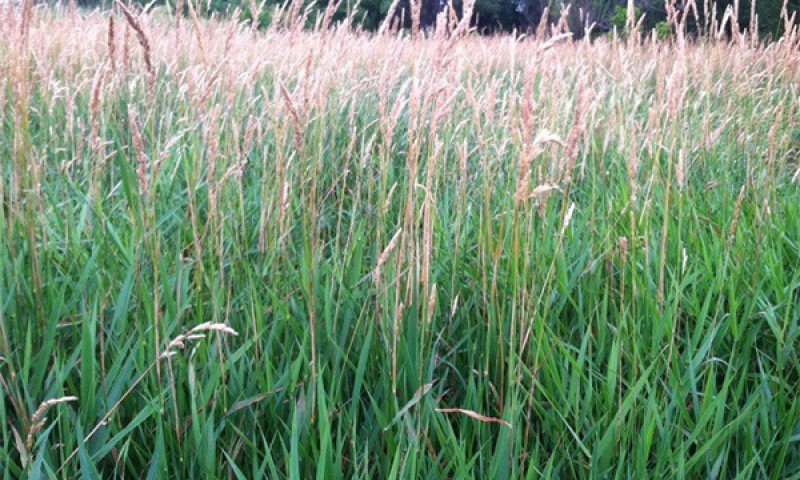
Figure 11. Reed Canarygrass Monoculture
This plant community contains predominately reed canarygrass and smooth bromegrass. Very few warm-season remnants are present. Production of reed canarygrass and smooth brome-dominated plant communities is highly variable, depending upon the percentages of composition present and outside inputs such as fertilizer and weed control. Tall fescue is often more common than smooth brome in the southern regions of the MLRA.
| Jan |
Feb |
Mar |
Apr |
May |
Jun |
Jul |
Aug |
Sep |
Oct |
Nov |
Dec |
| J |
F |
M |
A |
M |
J |
J |
A |
S |
O |
N |
D |
Pathway CP 2.1-2.2
Community 2.1 to 2.2
This community will be converted to a Smooth Bromegrass/Reed Canarygrass Community through the following practices:
Introduced grass seeding, excessive warm-season grazing, inadequate warm-season rest, multi-season haying, and nitrogen fertilizing in spring and/or fall.
Pathway CP 2.2-2.1
Community 2.2 to 2.1
Restoration can be achieved by herbicide treatment and reseeding. If adequate native remnants are present, appropriately timed prescribed fire and a follow-up prescribed grazing program may achieve the desired results.
| Prescribed Burning |
|
| Access Control |
|
| Prescribed Grazing |
|
| Herbaceous Weed Control |
|
State 3
Sod-busted State
This threshold is crossed as a result of mechanical disturbance and draining to facilitate production agriculture. If farming operations are suspended, the site can be abandoned, which will result in the Naturally Reclaimed Community, or be reseeded to a desired perennial forage mixture, which is described as the Reseeded Community.
Permanent alterations of the soil community and the hydrologic cycle make restoration to the original native Reference Community extremely difficult, if not impossible. Formation of a compacted plowpan in the soil profile is likely.
Community 3.1
Re-Seeded Grass
This plant community does not contain native remnants, and varies considerably depending upon the seed mixture, the degree of soil erosion, the age of the stand, nitrogen fertilizer use, and past grazing management. Prescribed grazing with adequate recovery periods will be needed to maintain productivity and desirable species.
Native range and seeded grasslands are ecologically different, and should be managed separately. Factors such as functional group, species, stand density, and improved varieties all impact the production level and palatability of the seedings. Species diversity is often limited, and when grazed in conjunction with native rangelands, uneven forage utilization may occur.
Total annual production during an average year varies significantly depending upon precipitation, management, and grass species seeded.
Community 3.2
Natural Reclamation
This plant community consists of annual and perennial weeds and less desirable grasses.
These sites have been farmed and abandoned without being reseeded. Soil organic matter/carbon reserves are reduced, soil structure is changed, and a plowpan or compacted layer can be formed, which decreases water infiltration. Residual synthetic chemicals may remain from farming operations. In early successional stages, this community is not stable. Erosion is a concern.
Total annual production during an average year varies significantly depending upon the succession stage of the plant community and any management applied to the system.
State 4
Invaded Woody State
Once the tree canopy cover reaches 15 percent with an average tree height exceeding five feet, the threshold is crossed to the Invaded Woody State. Woody species are encroaching due to lack of prescribed fire and other brush management practices. Typical ecological impacts are a loss of native warm-season grasses, degraded forage productivity, and reduced soil quality.
This state consists of the Deciduous Woody Phase.
Community 4.1
Deciduous Woody Phase
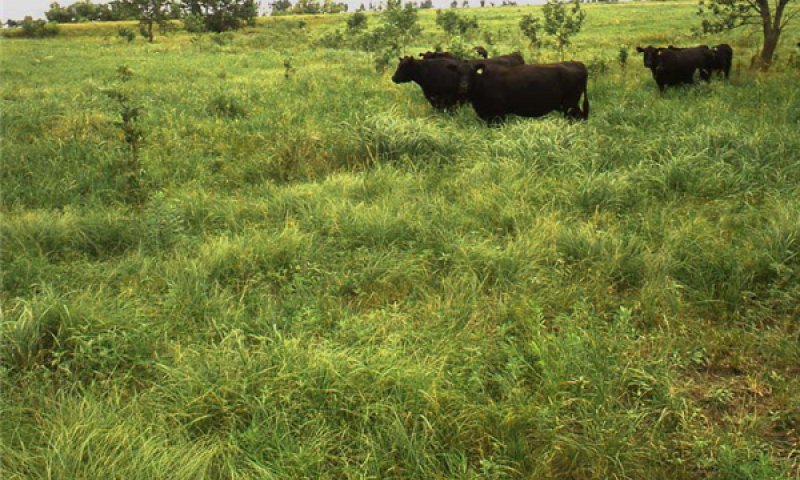
Figure 13. Invading Woody Species
Rough-leaved dogwood, honey locust, Siberian elm, cottonwood, ash, and willow are the primary invading species. Eastern redcedar is often present in this community as well.
Total annual production during an average year varies significantly, depending upon the production level prior to encroachment and the percentage of canopy cover.
Transition T1-2
State 1 to 2
Heavy grazing or haying without adequate recovery periods will cause this state to lose a significant proportion of tall and mid- warm-season grass species and cross a threshold to the Native/Invaded State. Water infiltration and other hydrologic functions will be reduced due to the root matting presence of sod-forming grasses. With the decline and loss of deeper penetrating root systems, soil structure and biological integrity are catastrophically degraded to the point that recovery is unlikely. Once this occurs, it is highly unlikely that grazing management alone will return the community to the Reference State.
Transition T1-3
State 1 to 3
The Reference State is significantly altered by mechanical tillage to allow the site to be placed into production agriculture. The disruption to the plant community, the soil and the hydrology of the system make restoration to a true reference state unlikely. The wetter sites are often ditched and drained, further altering the local hydrological cycle.
Transition T1-4
State 1 to 4
Disruption of the natural fire regime and the planting of invasive exotic and native woody species can cause this state to shift to the Invaded Woody State.
Transition T 2-3
State 2 to 3
The state is significantly altered by mechanical tillage to allow the site to be placed into production agriculture. The disruption to the plant community, the soil and the hydrology of the system make restoration to a true reference state unlikely.
Transition T 2-4
State 2 to 4
Disruption of the natural fire regime and the planting of invasive exotic and native woody species can cause this state to shift to the Invaded Woody State.
Transition T 3-4
State 3 to 4
Disruption of the natural fire regime and the planting of invasive exotic and native woody species can cause this state to shift to the Invaded Woody State.
Restoration pathway R4-1
State 4 to 1
Prescribed burning, wildfire, harvest, and brush management will move this state towards one of the herbaceous plant-dominated plant states. The forb component of a site with heavy tree density or canopy cover will initially increase following tree removal through mechanical brush management treatments and prescribed fire. Neither the Sod-busted State nor the Native/Invaded State can return to the Reference State through this process, as the native plant community, soils, and hydrological cycle have been too severely degraded.
If re-sprouting brush such as honey locust or Siberian elm is present, stumps must be chemically treated immediately after mechanical removal. Ongoing brush management such as mechanical removal, chemical spot treatments, or periodic prescribed burning is required to prevent a return to this state.
| Brush Management |
|
| Prescribed Burning |
|
| Prescribed Grazing |
|
Restoration pathway R4-2
State 4 to 2
Prescribed burning, wildfire, harvest, and brush management will move this state towards one of the herbaceous plant-dominated plant states. The forb component of a site with heavy tree density or canopy cover will initially increase following tree removal through mechanical brush management treatments and prescribed fire. Neither the Sod-busted State nor the Native/Invaded State can return to the Reference State through this process, as the native plant community, soils, and hydrological cycle have been too severely degraded.
If re-sprouting brush such as honey locust or Siberian elm is present, stumps must be chemically treated immediately after mechanical removal. Ongoing brush management such as mechanical removal, chemical spot treatments, or periodic prescribed burning is required to prevent a return to this state.
| Brush Management |
|
| Prescribed Burning |
|
| Prescribed Grazing |
|
Restoration pathway R4-3
State 4 to 3
Prescribed burning, wildfire, harvest, and brush management will move this state towards one of the herbaceous plant-dominated plant states. The forb component of a site with heavy tree density or canopy cover will initially increase following tree removal through mechanical brush management treatments and prescribed fire. Neither the Sod-busted State nor the Native/Invaded State can return to the Reference State through this process, as the native plant community, soils, and hydrological cycle have been too severely degraded.
If re-sprouting brush such as honey locust or Siberian elm is present, stumps must be chemically treated immediately after mechanical removal. Ongoing brush management such as mechanical removal, chemical spot treatments, or periodic prescribed burning is required to prevent a return to this state.
| Brush Management |
|
| Prescribed Burning |
|
| Prescribed Grazing |
|


